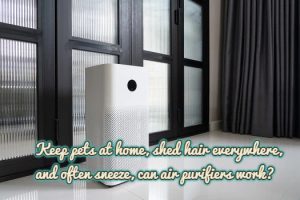Keep pets at home, shed hair everywhere, and often sneeze, can air purifiers work?
- by 人生
- February 23, 2022
Furry pets can bring air purifier for pet odor warmth and friendship, but they can also be annoying, with three of the most common problems: pet hair, allergens, and odor.
So, is it suitable for families with pets to buy ambient air into the purifier?
Let's start with pet hair
It's not realistic to rely on an air purifier to cleanse your pet's hair.
Pet hair can fall out at any time, often appearing in flakes and clumps, and air purifiers can't clean bulky hair, including small fluff floating in the air, and neither can they.
On the contrary, if these hairs enter the air purifier, it will cause the air inlet and the screening program to be blocked, which will greatly reduce the purification efficiency and affect the air purification effect.
Pet hair can only be removed by regular cleaning, vacuuming, hair stickers, etc.
Tip: But if there are people who are prone to allergies at home, we need to choose a vacuum cleaner carefully, because while absorbing pet hair, Chinese vacuum cleaners will also make pet allergens attached to the hair. It has a serious impact on the life of people with allergies.
But air purifiers play a very important role in purifying pet allergens.
pet allergens
Many people believe that pet allergies are caused by their hair, which is actually a myth.
It's a tiny protein that really causes allergies. Feline allergenic protein fel d is present in cat hair, dander, saliva and feces, and is widely present in the air during pet hair removal, hair licking, sneezing and defecation.
Compared with pet hair that can be seen with the naked eye, pet dander and aerosol particles that carry allergenic proteins in a large amount of data are often only a few tens of microns or even a few microns in size. These tiny allergens can be suspended for a long time. In the air, it enters the Chinese human body through its own breathing and direct contact with the skin, causing severe allergic reactions.
And air purifiers can cleanse these very tiny allergens.
Allergens are usually absorbed by the screener/screener element to dry and remain in the purifier (but the screener should be replaced regularly, otherwise once the screener is saturated, the allergen will be re-released into the air).
There are also air purifiers, which use an ion waterfall process to instantly release a large amount of positive and negative ions, accurately capture allergens in the air, and push them to the collection wall at high speed. Air purifiers do not need to be replaced, but do require regular self-cleaning.
Recommended articles
How to choose the right air purifier for yourself? These three points are especially important
Don't know how to choose an air purifier? Don't panic, we'll know when we're done
Don't know how to use the air purifier after buying it? These seven points should be remembered
其他文章推薦
